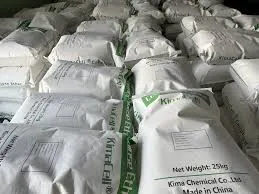
Nov . 28, 2024 01:47 Back to list
Solubility Analysis of Hydroxyethyl Cellulose in Ethanol Solutions
Understanding Hydroxyethyl Cellulose (HEC) Solubility in Ethanol Implications and Applications
Hydroxyethyl cellulose (HEC) is a non-ionic, water-soluble polymer derived from cellulose. It has gained prominence in various industrial and research applications due to its unique properties, including thickening, gelling, and film-forming capabilities. One significant aspect of HEC that warrants attention is its solubility in different solvents, particularly ethanol. This article explores the factors influencing HEC solubility in ethanol, the implications of this solubility, and potential applications across various fields.
Structure and Properties of HEC
Before delving into the solubility of HEC in ethanol, it's crucial to understand its chemical structure. HEC is modified cellulose in which hydroxyethyl groups are introduced into the cellulose backbone. This modification alters the physical and chemical properties of cellulose, making it more soluble in organic solvents, including ethanol. The degree of substitution (DS), which refers to the number of hydroxyethyl groups per glucose unit in the cellulose chain, has a direct impact on the solubility of HEC. Generally, a higher DS results in increased solubility.
Solubility of HEC in Ethanol
HEC is primarily soluble in water due to its hydrophilic nature. However, its solubility in ethanol is a topic of interest, especially when considering formulations that require both hydrophilic and hydrophobic components. Ethanol, being a polar solvent, can dissolve certain grades of HEC to a limited extent. Factors that influence the solubility of HEC in ethanol include
1. Molecular Weight Higher molecular weight HEC tends to have lower solubility in ethanol compared to lower molecular weight variants. This is due to increased intermolecular interactions in high molecular weight polymers, which can inhibit solvation.
2. Degree of Substitution As mentioned earlier, the degree of hydroxyethyl substitution can enhance solubility. HEC with a higher DS has more hydrophilic groups, which can interact favorably with ethanol.
3. Temperature Temperature plays a crucial role in solubility. Generally, increasing the temperature of the solvent can improve the solubility of HEC in ethanol due to enhanced molecular movement and reduced viscosity of the solvent.
hydroxyethyl cellulose solubility in ethanol

Applications of HEC in Ethanol-Based Formulations
The ability of HEC to dissolve in ethanol expands its utility in various applications, particularly in the pharmaceutical, cosmetic, and food industries. Some notable applications include
1. Pharmaceuticals HEC serves as a stabilizer and thickening agent in liquid formulations such as suspensions and oral solutions. Its limited solubility in ethanol allows for the creation of controlled-release formulations, where the active ingredients are slowly released in the digestive system.
2. Cosmetic Products In cosmetics, HEC is often used as a thickener and emulsifier in lotions and creams. Its compatibility with ethanol makes it ideal for formulating products that require both water and alcohol, enhancing texture and stability.
3. Food Industry HEC is used as a food additive, providing texture and improving mouthfeel in various products. Its solubility characteristics are leveraged in alcoholic beverages and sauces, where it aids in maintaining stability and consistency.
Conclusion
In summary, hydroxyethyl cellulose's solubility in ethanol is a significant factor influencing its diverse applications in various industries. Understanding how factors such as molecular weight, degree of substitution, temperature, and concentration affect solubility can help formulators optimize HEC-based products. As the demand for innovative formulations continues to rise, HEC's unique properties ensure that it remains an essential ingredient in numerous applications. Exploring and leveraging its solubility in ethanol can lead to advancements in product development across multiple sectors, underscoring the importance of this versatile polymer in modern formulation science.
-
Versatile Hpmc Uses in Different Industries
NewsJun.19,2025
-
Redispersible Powder's Role in Enhancing Durability of Construction Products
NewsJun.19,2025
-
Hydroxyethyl Cellulose Applications Driving Green Industrial Processes
NewsJun.19,2025
-
Exploring Different Redispersible Polymer Powder
NewsJun.19,2025
-
Choosing the Right Mortar Bonding Agent
NewsJun.19,2025
-
Applications and Significance of China Hpmc in Modern Industries
NewsJun.19,2025







